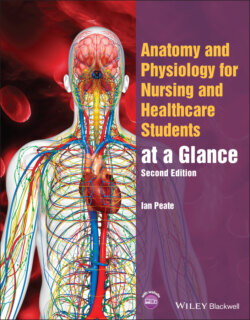Читать книгу Anatomy and Physiology for Nursing and Healthcare Students at a Glance - Ian Peate - Страница 4
List of Illustrations
Оглавление1 Chapter 1Figure 1.1 The standard anatomical position. Figure 1.2 Anatomical terms. Figure 1.3 Anatomical planes. Figure 1.4 Body cavities.
2 Chapter 2Figure 2.1 DNA and RNA. Figure 2.2 Mitosis. Figure 2.3 Meiosis. Figure 2.4 Fertilisation.
3 Chapter 3Figure 3.1 Components of a negative feedback system. Figure 3.2 Negative feedback – raised blood pressure. Figure 3.3 Negative feedback – raised temperature. Figure 3.4 Positive feedback of childbirth.
4 Chapter 4Figure 4.1 Body water content. Figure 4.2 Fluid compartments.
5 Chapter 5Figure 5.1 Structures located within body cells. Figure 5.2 Mitochondrion. Figure 5.3 The fluid mosaic arrangement.
6 Chapter 6Figure 6.1 Simple diffusion. Figure 6.2 Channel‐mediated facilitated diffusion of potassium ions (K+) thr...Figure 6.3 Osmosis. Water molecules move through the selectively permeable m...Figure 6.4 Tonicity and the red blood cell.
7 Chapter 7Figure 7.1 Centrifuged blood. Figure 7.2 Three principal formed components: red blood cells, white blood c...Figure 7.3 Compoments of blood. Figure 7.4 Haemopoiesis.
8 Chapter 8Figure 8.1 Types of acquired immunity. Figure 8.2 The cells of the immune system.
9 Chapter 9Figure 9.1 Levels of organisation. Figure 9.2 Types of cells. Figure 9.3 Human body tissues.
10 Chapter 10Figure 10.1 The brain. Figure 10.2 The meninges. Figure 10.3 The neuron. Figure 10.4 The cranial nerves.
11 Chapter 11Figure 11.1 The cerebrum. Figure 11.2 The cerebellum. Figure 11.3 The limbic system.
12 Chapter 12Figure 12.1 Spinal cord and spinal nerves. Figure 12.2 The meninges.
13 Chapter 13Figure 13.1 The circle of Willis. Figure 13.2 The blood–brain barrier.
14 Chapter 14Figure 14.1 The sympathetic and parasympathetic nervous systems.
15 Chapter 15Figure 15.1 The somatic nervous system. Figure 15.2 The motor pathway.
16 Chapter 16Figure 16.1 The location of the heart. Figure 16.2 The walls of the heart. Figure 16.3 Cells of the myocardium. Figure 16.4 Myocardial cells.
17 Chapter 17Figure 17.1 Blood flow through the heart. Figure 17.2 The blood vessels of the heart. Figure 17.3 The coronary veins.
18 Chapter 18Figure 18.1 The conducting system of the heart. Figure 18.2 The cardiac cycle.
19 Chapter 20Figure 20.1 The blood vessels. Figure 20.2 Layers of the blood vessels. Figure 20.3 Comparison of an artery, vein and capillary. Figure 20.4 Capillary network.
20 Chapter 21Figure 21.1 The baroreceptors. Figure 21.2 Blood pressure measurement.
21 Chapter 22Figure 22.1 The lymphatic system and organs. Figure 22.2 The lymphatic capillaries. Figure 22.3 Lymph node.
22 Chapter 23Figure 23.1 The respiratory organs. Figure 23.2 Detailed structures of the respiratory tract. Figure 23.3 The lower respiratory tract. Figure 23.4 Bronchial tree.
23 Chapter 24Figure 24.1 Boyle’s Law. Figure 24.2 Inspiration and expiration.
24 Chapter 25Figure 25.1 The respiratory centre. Figure 25.2 Peripheral chemoreceptors.
25 Chapter 26Figure 26.1 External respiration. Figure 26.2 Gas exchange in the lungs. Figure 26.3 Internal respiration.
26 Chapter 27Figure 27.1 The upper and lower gastrointestinal tract. Figure 27.2 The tongue. Figure 27.3 Swallowing action. Figure 27.4 The stomach.
27 Chapter 28Figure 28.1 The small intestine. Figure 28.2 The large intestine.
28 Chapter 29Figure 29.1 The liver, gall bladder and pancreas. Figure 29.2 Liver lobules. Figure 29.3 Bile production and secretion.
29 Chapter 30Figure 30.1 The pancreas.
30 Chapter 31Figure 31.1 Digestion and absorption.
31 Chapter 32Figure 32.1 A nephron. Figure 32.2 Bowman’s capsule.
32 Chapter 33Figure 33.1 External layers of the kidney. Figure 33.2 Blood flow through the kidney.
33 Chapter 34Figure 34.1 Blood supply to the ureter. Figure 34.2 The urinary bladder. Figure 34.3 The male urethra. Figure 34.4 The female urethra.
34 Chapter 35Figure 35.1 Renal filtration. Figure 35.2 Renin‐angiotensin pathway.
35 Chapter 36Figure 36.1 The left testis and epididymis. Figure 36.2 Sagittal view of the penis and male pelvis. Figure 36.3 The anatomy of the penis.
36 Chapter 37Figure 37.1 The prostate gland.
37 Chapter 38Figure 38.1 Spermatogenesis. Figure 38.2 Primary and secondary sex characteristics.
38 Chapter 39Figure 39.1 The female reproductive organs.
39 Chapter 40Figure 40.1 The external female genitalia.
40 Chapter 41Figure 41.1 The breast. Figure 41.2 The breast and surrounding structures. Figure 41.3 Lobules and ducts. Figure 41.4 The axillary lymph nodes. Figure 41.5 Breast lymph.
41 Chapter 42Figure 42.1 Hormonal regulation of the changes in the ovary and uterus. Figure 42.2 Changes in the concentration of anterior pituitary and ovarian h...
42 Chapter 43Figure 43.1 The major endocrine glands. Figure 43.2 The pituitary gland and surrounding structures.
43 Chapter 44Figure 44.1 The thyroid and parathyroid glands. Figure 44.2 Control of thyroid hormone production – negative feedback.
44 Chapter 45Figure 45.1 The pancreas. Figure 45.2 Insulin and glucagon effects on blood glucose.
45 Chapter 46Figure 46.1 Bone remodelling. Figure 46.2 Bone growth. Figure 46.3 Osteon, Haversian canal.
46 Chapter 47Figure 47.1 The skeleton: axial and appendicular. Figure 47.2 Compact bone (long bone). Figure 47.3 Short bone. Figure 47.4 Flat bone. Figure 47.5 Irregular bone. Figure 47.6 Sesamoid bone.
47 Chapter 48Figure 48.1 Joint types.
48 Chapter 49Figure 49.1 Muscle tissues.
49 Chapter 50Figure 50.1 The skin and associated structures. Figure 50.2 Skin types. Figure 50.3 The layers of the epidermis.
50 Chapter 51Figure 51.1 The hair and associated glands. Figure 51.2 The nails.
51 Chapter 52Figure 52.1 Epidermal and deep wound healing.
52 Chapter 53Figure 53.1 Summary of wound healing events.
53 Chapter 54Figure 54.1 The eye. Figure 54.2 The lacrimal apparatus.
54 Chapter 55Figure 55.1 The ear. Figure 55.2 The outer ear. Figure 55.3 The middle ear. Figure 55.4 The inner ear.
55 Chapter 56Figure 56.1 Pathway of smell. Figure 56.2 Olfactory epithelium and olfactory receptor cells. Figure 56.3 The olfactory bulb (nerve).
56 Chapter 57Figure 57.1 The tongue. Figure 57.2 Taste.
